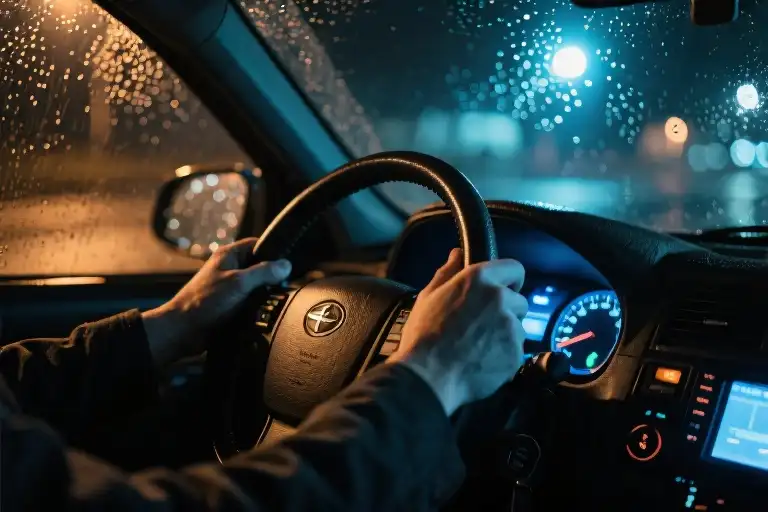The steering wheel felt unnaturally cold under my fingers, its leather ridges pressing tiny moons into my palms. Outside, the streetlights flickered like faulty fireflies, casting uneven shadows across the dashboard. A steady hum of tires against asphalt filled the car, punctuated by the occasional crunch of gravel beneath the wheels. This was my seventh time driving home along this stretch of road this week, maybe the seventy-seventh time this year. Routine should have sanded down the edges of this experience until it felt smooth and unremarkable. Instead, every sensation seemed amplified, each detail vibrating with unnatural clarity.
My breath fogged the windshield slightly as I exhaled, the condensation disappearing almost immediately in the climate-controlled air. The radio played some forgettable pop song at a volume just loud enough to register but too quiet to follow the lyrics. Normally, this would be background noise to my thoughts, the kind of drive where I’d mentally replay work emails or plan tomorrow’s lunch. But tonight, the ordinary had sharpened into something almost painful in its intensity. The way the yellow dividing lines pulsed toward me in the headlights. How the rearview mirror caught fragments of passing headlights like disjointed Morse code. The faint smell of coffee from this morning’s travel mug still clinging to the cupholder.
My thumbs tapped an uneven rhythm against the steering wheel’s curve. There was something unsettling about how easily the wheel turned beneath my hands, how little pressure it would take to veer sharply left into the opposite lane. The thought arrived fully formed, without drama or fanfare: I could end everything right now with one swift turn. What shocked me wasn’t the darkness of the thought, but how matter-of-fact it felt, as mundane as deciding whether to stop for gas. This wasn’t the cinematic despair you see in movies – no sobbing, no screaming into the void. Just quiet, clinical recognition of how fragile the barrier between ‘fine’ and ‘not fine’ really is.
A truck passed in the opposite direction, its headlights flooding my car with temporary daylight. In that stark illumination, I noticed how tightly my knuckles had gone white around the wheel. Some distant part of my brain began counting the rhythmic thumps of power lines overhead, each one marking another hundred feet of road where nothing bad had happened yet. The air conditioning vent directed a stream of cold air onto my wrist, making the fine hairs stand at attention. Small, meaningless details that somehow anchored me to the moment when bigger things – like survival instincts – seemed to be malfunctioning.
At the next red light, I became acutely aware of my phone resting in the center console. The screen lit up with a notification – some app updating, nothing important. But the glow reminded me of other screens, other nights when typing ‘I’m not okay’ into a text field felt impossible. The light changed to green before I realized I’d been holding my breath. As the car rolled forward, my right hand drifted from the wheel of its own volition, fingertips brushing against the phone’s edge. Muscle memory navigated to the contact before my conscious mind caught up: one tap on the favorites star, two on the call button. Somewhere beneath the static of panic, a quiet voice insisted this was what people who wanted to live did – they reached for lifelines, however unsteady.
The dial tone buzzed once, twice. On the third ring, the streetlights blurred into golden streaks through suddenly wet eyes. Then, a sound so ordinary it shattered everything: ‘Hello?’ in my mother’s particular cadence, the way she always lifted the end of the word like it was a gift she was handing me. My index finger hovered over the end call button, trembling. Outside, the world kept moving – cars passed, traffic signals cycled, the night air hummed with invisible energy. But inside the car, time fractured into before and after that single word. Hello.
The Perfect Specimen of Normalcy
The air conditioning hummed at precisely 21°C – that clinical temperature between comfort and slight unease. NPR played softly through speakers that hadn’t quite recovered from last winter’s spilled coffee incident, the voices occasionally breaking into static when passing under bridges. My phone glowed on the passenger seat, notifications stacking vertically like a precarious Jenga tower of unanswered texts and calendar reminders.
Right hand on the wheel at exactly 4 o’clock position. Left hand… wait, where was my left hand? The sudden awareness jolted through me like a misstep on stairs. There it was – already moving toward the door lock, index finger pressing the button with ritualistic precision. Click. Unclick. Click. The metallic sound barely audible over the radio’s interview about sustainable fisheries.
Three locks engaged. Three disengaged. Three re-engaged. The pattern completed itself through muscle memory while my eyes tracked the dotted highway lines. White. Space. White. Space. The rhythm syncopated with the windshield wipers clearing nonexistent rain. My coffee sat cooling in the cup holder, its surface developing the faintest skin of neglect.
Everything about this scene screamed ordinary – the kind of unremarkable commute that wouldn’t warrant a single frame in life’s highlight reel. Yet beneath this textbook demonstration of routine, something thrummed like a live wire wrapped in cotton. The radio journalist’s voice became distant as I noticed my own reflection in the rearview mirror – pupils slightly dilated, jaw tighter than the cruise control setting.
The phone buzzed again. A calendar alert: ‘Call Mom re: birthday plans.’ My thumb hovered over the notification as the car maintained its steady 62 mph. The digital clock read 7:14 PM. Outside, streetlights began flickering to life, their orange glow catching raindrops that hadn’t yet fallen.
When Darkness Creeps Through the Cracks
The headlights hit like a physical blow – that sudden, blinding glare from the oncoming semi-truck. For three heartbeats (I counted), the world reduced to white noise and retinal burns. When vision returned, the steering wheel leather had left an imprint of its crosshatch pattern deep in my palms. Not just an impression – the grooves actually ached, as if the pressure had transferred through skin into bone.
That’s when the counting started. Not seconds this time, but the concrete barriers flanking the overpass. Forty-two… forty-three… the rhythm matching my shallow breathing. A nonsensical compulsion, yet the numbers anchored me even as part of my brain whispered how easy it would be to misjudge the next curve.
Three physiological truths emerged simultaneously:
- My shirt collar stuck to the back of my neck despite the AC blasting
- The taste of copper flooded my mouth (when had I bitten my cheek?)
- Both hands remained locked at 10-and-2 position, thumbs numb from pressure
The radio played some forgettable pop song, the kind with lyrics about careless summers. The dissonance between that manufactured joy and my white-knuckle reality triggered something visceral. For the first time, I understood how emotional survival skills aren’t about grand gestures – they’re measured in millimeters. The slight tilt of wrists to maintain lane position. The deliberate unclenching of jaw muscles. The act of blinking away afterimages from those brutal headlights.
What surprised me most? The ordinary details that became lifelines. A green exit sign reflecting in my rearview. The faint smell of peppermint from the gum wrapper in the cup holder. These became my invisible mental struggle toolkit – sensory anchors pulling me back from the edge where dark thoughts pooled.
Later, I’d recognize this as textbook depersonalization. In the moment, it simply was: the steering wheel’s cold grip, the hypnotic rhythm of dashed lane markers, the terrifying clarity with which I could envision swerving. Not wanting to die, but craving cessation – that ambivalent suicidal ideation that feels like standing at an open freezer in July, simultaneously drawn to and repelled by the cold.
The mind’s emergency protocols kick in strangely:
- Vision tunnels to focus solely on brake lights ahead
- Hearing amplifies tire noise to mask intrusive thoughts
- Fingers automatically seek phone’s emergency call shortcut
What saved me that night wasn’t some profound revelation. It was muscle memory dialing, the shock of a human voice saying “Hello?” piercing through the mental static. Sometimes crisis intervention looks like your mother asking if you remembered to buy milk.
We don’t talk enough about these micro-moments of decision – how choosing to endure can be as simple as counting bridge joints until the wave passes. How survival often wears the face of mundane routine: signaling properly, checking blind spots, coming to a full stop at empty intersections. The banal mechanics of staying alive.
The War Inside
The digital clock on the dashboard flickered – 8:17, 8:18, then suddenly 8:▯▯. The numbers dissolved into meaningless pixels as my vision blurred. Two voices erupted in my skull, each fighting for dominance over my trembling hands still glued to the steering wheel.
“Just let go,” whispered the first voice, smooth as the leather grooves pressing into my palms. “One sharp turn. No more invisible chains.”
Then came the second voice, softer but persistent – “Mom has her oncology checkup Wednesday.” Simple. Domestic. Devastating. Behind my eyelids flashed a memory from fifteen years ago: strawberry candies in a paper bag on the backseat, their sweet-tart scent mixing with Mom’s lavender perfume as she drove me to third grade.
My foot hovered between accelerator and brake. The conflicting thoughts came faster now:
- The bridge railing looks flimsy enough (but who would walk her rescue dogs?)
- This pain has to stop (but she still texts “goodnight sweetheart” every evening at 10:15)
- No one would even (except the barista who memorized my oat milk order)
The air conditioning hummed the same tone as the MRI machine during Mom’s last scan. Outside, traffic lights bled into streaks of green and red like childhood crayon drawings left in the sun. Somewhere beneath the static in my brain, a realization surfaced: this wasn’t about dying. It was about the exhausting work of staying alive when your mind becomes a battlefield.
Then – a miracle. My right thumb moved on its own, sliding across the phone screen to the contact labeled “Home.” As the call connected, I noticed three things simultaneously:
- The time had resolved back to 8:24
- A half-finished iced coffee sweating in the cupholder
- The candy wrapper still tucked in my wallet after all these years
The dial tone changed. Somewhere beyond the chaos, a phone started ringing.
When Muscle Memory Saves You
The steering wheel leather had left angry red imprints on my palms, a physical testament to the silent battle raging inside. Then something remarkable happened – my right hand moved on its own. Like a sleepwalker performing rehearsed steps, my fingers released their death grip and floated toward the phone mount. This wasn’t conscious decision-making; this was survival muscle memory kicking in when my mind had gone offline.
Three things registered in rapid succession:
- The thumbprint scanner recognized me before I recognized what I was doing. That tiny green checkmark appeared like an old friend nodding ‘I’ve got you’.
- The call log displayed the same contact at the top for the 27th consecutive day – ‘Mom’ with a sunflower emoji beside it. The pattern of those nightly 9:13pm calls now formed a lifeline I hadn’t realized I’d been weaving.
- The dial tone changed pitch as the call connected. That subtle shift from dull beeps to expectant silence traveled through my ear canal and somehow reached the paralyzed parts of my brain.
This is what emotional survival skills look like in practice – your body remembering the exit routes your mind has forgotten. That automatic reaching for connection isn’t weakness; it’s your nervous system’s brilliant contingency plan. Like emergency lighting activating during a power outage, these micro-actions guide us toward safety when our emotional circuits overload.
Notice the physical details next time you’re in crisis:
- Which hand moves first?
- What shortcut does it seek?
- How does your breathing change when the ringing starts?
These aren’t random occurrences – they’re your personal non-clinical coping methods, engraved in your cells through repetition. That call log isn’t just a list; it’s a map showing where your heart goes to find shelter.
When the Phone Rings at Rock Bottom
The car interior hums with the muffled sound of road noise and my own ragged breathing. Through the windshield, streetlights smear into golden streaks as tears distort my vision – those same lights that seemed so indifferent minutes ago now pulse with strange warmth. My thumb hovers over the phone’s red disconnect icon, trembling with the aftershocks of adrenaline.
Then her voice comes through the speakers, tinny with Bluetooth compression but unmistakably real: “Sweetheart? You’re home late.” It’s the same greeting she’s used since high school, when she’d wait up with a plate of reheated dinner. The familiarity of it cracks something open in my chest.
Three things happen simultaneously:
- My lungs remember how to expand fully
- The dashboard clock resolves from blurred digits to 11:47PM
- I notice the half-finished iced coffee in the cupholder, condensation still beading on the plastic lid
This is how mental health crisis moments often end – not with dramatic resolutions, but with ordinary details reasserting their reality. The mind that just contemplated swerving into darkness now fixates on practicalities: “Should I mention the doctor’s appointment? Did I leave the porch light on?”
Research shows most suicidal impulses peak and pass within 90 minutes. What gets people through that window isn’t profound wisdom or professional intervention (though those help), but often simple human connection – exactly why reaching for your phone can be literal lifesaving first aid. That reflexive dialing of a trusted contact creates what psychologists call a “circuit breaker” for destructive thoughts.
My mother is saying something about the neighbor’s new puppy when I finally register the tension in my hands. They’ve migrated back to the steering wheel at 10-and-2, grip so tight the leather creaks. I force each finger to uncurl, pressing my palms flat against my thighs where the fabric is still warm from the car heater. The action feels strangely ceremonial, like unbuckling a parachute after a rough landing.
Outside, the distorted light halos around streetlamps have sharpened back into distinct circles. The crisis hasn’t vanished – I can still feel its shadow lurking at the edges of my vision – but the immediate danger has passed. For now, that’s enough.
“Mom?” My voice sounds foreign to my own ears. “Can you tell me about your day?”
Because sometimes survival looks like this: holding onto a familiar voice while the world stops spinning. Noticing how headlights paint moving patterns on the garage door. Realizing you want to hear about someone else’s ordinary Tuesday. The small, unheroic acts that anchor us back to life when we’ve drifted too close to the edge.





